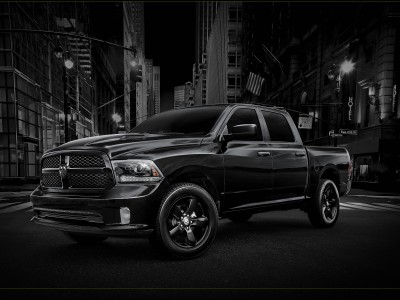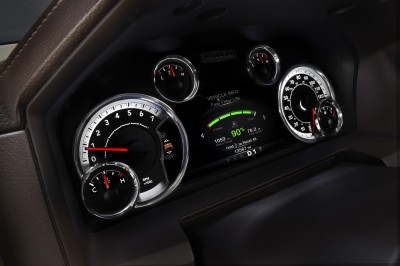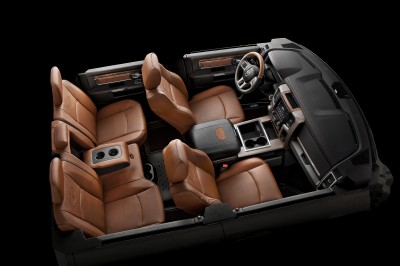 In our continuing effort to take back the phrase “That’s So Gay”, Gaywheels is proud to tell you about one of the gayest trucks out there: the Ram 1500. (Remember folks: gay is a good thing.)
In our continuing effort to take back the phrase “That’s So Gay”, Gaywheels is proud to tell you about one of the gayest trucks out there: the Ram 1500. (Remember folks: gay is a good thing.)
When it comes to big and impressive trucks — and who doesn’t like toys that are big and impressive? — few can compete with the Ram. Fellow Gaywheels writer Casey Williams loved it. So did I. And so did Texas and Colorado auto writers, Motor Trend magazine, and the North American International Auto Show, all of which named it Truck of the Year. Here’s why:
On the surface, the 2013 Ram has styling cues and visible toughness that command attention. The top-tier trim is the Laramie, a classy, butch truck that looks great, either standing still or in motion. The grille features a very prominent steel-looking Ram’s head, the traditional logo for the Ram brand. This year’s emblem is bigger than ever, and you can’t miss it, since it’s intentionally intimidating, coming right at chest level.
 Performance is top-notch all the way around. The Ram is considered a light-duty truck, with the heavy-duty capacity to tow up to 6,500 lbs. That’s actually quite heavy duty, depending on your duty.
Performance is top-notch all the way around. The Ram is considered a light-duty truck, with the heavy-duty capacity to tow up to 6,500 lbs. That’s actually quite heavy duty, depending on your duty.
One feature that is new for 2013 (and really quite impressive) is the ability to raise or lower the ground clearance by two-inches instantly. One or two inches may not seem like much, but having that on-demand height bump can mean the difference between rising above it all or letting your underside get thoroughly scratched.
There are many, many standard equipment and optional features that come with this year’s Ram, including accessory packages like the Big Horn or Lone Star Equipment Group. If you’re the kind of person who likes to visit Cabela’s or Bass Pro Shop just to whiff the heightened testosterone, you’ll love the 2013 Ram. You can smell the masculinity a mile away.
So then…what makes this truck so gay?
In bear parlance, the butchness of the 2013 Ram 1500 earns it one very big WOOF*! Several big woofs, in fact. That’s gay in a good way — a great way, even. To be sure, a ‘woof!’ doesn’t necessarily speak to content, but it does say that you’re a package to be seen in public and shown around to your friends.
 The marketing campaign for this granddaddy of trucks has been ‘Guts-Glory’, a play on the dual themes of toughness and patriotism. It’s over the top, to be sure, and the theme took an ugly turn when Dodge aired a Super Bowl commercial featuring Paul Harvey’s voice honoring the American farmer. Given Harvey’s right-wing credentials, it came off as anti-gay, but since then, Ram commercials have been fairly tame, airing during shows like Vikings and Game of Thrones.
The marketing campaign for this granddaddy of trucks has been ‘Guts-Glory’, a play on the dual themes of toughness and patriotism. It’s over the top, to be sure, and the theme took an ugly turn when Dodge aired a Super Bowl commercial featuring Paul Harvey’s voice honoring the American farmer. Given Harvey’s right-wing credentials, it came off as anti-gay, but since then, Ram commercials have been fairly tame, airing during shows like Vikings and Game of Thrones.
Soon, the 2013s will be making way for the 2014 models, which promise to be even more impressive. If you’re in the mood to buy a truck and really don’t know or care about the differences from year to year, shop for a Ram and you may find many dealers ready to cut a deal to get the remaining 2013 models off the lot.
Just make sure you have a place to park it. All that hotness won’t do you any good if you can’t put it where it ought to go.
* I know it sounds strange for human bears to use the term ‘woof’, since that’s not a sound that real bears make. I don’t know how this happened — though some point to the late Madeline Kahn. All I can say for sure is that ‘woof’ has evolved over the years to become a high bear compliment. Personally, I love it when another man woofs at me. Makes me feel like all those years studying the English language was worth it.

Great story, Sam!
Air suspension is nothing new – lots of Ford Expeditions and Lincoln Navigators had it 10 years ago. It was called “air leveling suspension,” and it had the added benefit of lowering the vehicle to reduce climb-in height, raising the vehicle off-road, and lowering the vehicle on the highway to reduce drag. It was unreliable.
Considering Chrysler’s quality history, I think it’s a good idea to wait a while before giving them credit for this feature and others…there’s every reason to believe these trucks will have problems. At least if the data between 1980 and 2005 is any indicator.